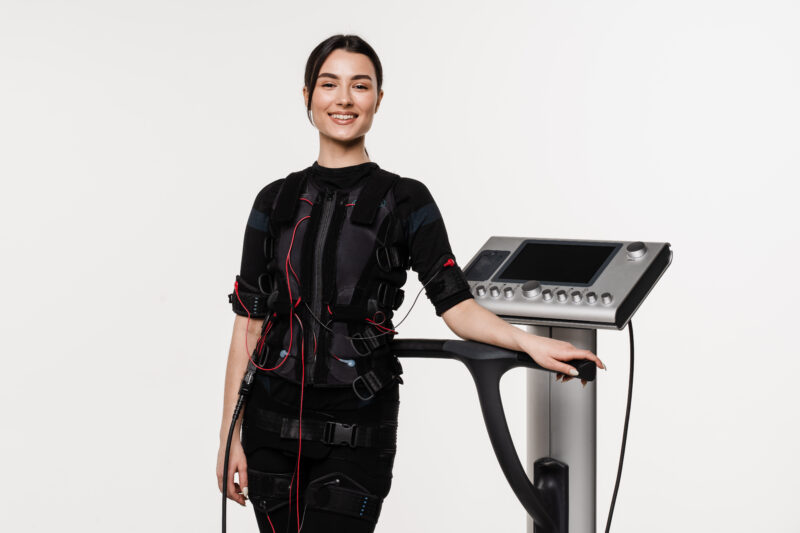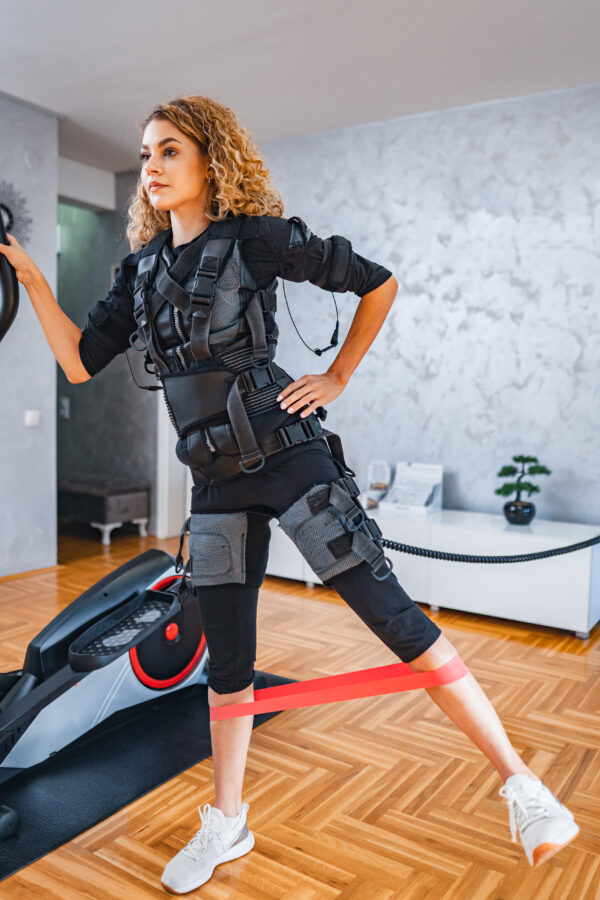Can a 20-Minute EMS Session Really Replace an Hour of Training?
Lifting, jumping, balancing, breathing – can a few electrical impulses really do all that for you?
EMS training claims it can. Twenty minutes in a suit that sends electrical currents through your body, contracting your muscles while you stand, squat, or move lightly. It promises the same results as a full workout in half the time.
But can it truly replace what happens when you move—when your brain, muscles, and nervous system all work together?
What EMS Actually Does
Electromyostimulation (EMS) uses electrical impulses to cause involuntary muscle contractions. The technology isn’t new – it’s been used in physical therapy for decades to help people regain muscle function after injury or surgery.
In recent years, however, it’s been marketed to healthy individuals as a “shortcut” to strength and fat loss.
Research shows EMS can increase muscle strength and mass to some degree. For example, a meta-analysis published in the Journal of Strength and Conditioning Research (2021) found that EMS can stimulate hypertrophy and strength gains comparable to low-to-moderate resistance training in untrained or rehabilitating individuals【1】.
But there’s a catch. The effect largely depends on intensity, duration, and frequency—and even then, EMS lacks the neuromuscular coordination and mechanical load that traditional training provides.
What It’s Useful For
There are legitimate uses for EMS:
- Rehabilitation and recovery – EMS can help preserve muscle mass and neural activation during immobilization or post-injury【2】.
- Supplementary activation – It can add a layer of muscular stimulation to targeted areas when combined with conventional training, potentially enhancing strength when used strategically【3】.
- Older adults or special populations – EMS may benefit those who cannot tolerate heavy resistance due to age, illness, or injury【4】.
So yes – EMS can be a tool. But it’s not the tool.
What It Cannot Replace
Healthy, able-bodied individuals don’t just need stronger muscles – they need a well-integrated neuromuscular system.
When you lift weights, jump, or balance, your body is learning how to produce, transfer, and absorb force. That process involves:
- Proprioception (your body’s awareness of position and movement)
- Neuroplasticity (your brain adapting to new motor patterns)
- Intermuscular coordination (muscles working together efficiently)
- Load tolerance and connective tissue adaptation (tendons, bones, fascia strengthening under real stress)
EMS bypasses nearly all of that.
The electrical current doesn’t require your brain to learn or your body to stabilize. It contracts the muscles, yes – but without the central nervous system actively controlling those contractions.
That’s why athletes who depend on speed, agility, or precision (like sprinters, dancers, or gymnasts) wouldn’t replace their plyometric or strength work with EMS. Those movements build far more than muscle – they develop the brain-body connection that drives long-term performance, coordination, and injury prevention.
In fact, studies show that voluntary contractions during exercise result in greater neural activation and motor unit recruitment synchronization than external stimulation alone【5】. That means your nervous system learns better through real movement, not passive contraction.
The “Shortcut” Illusion
The appeal of EMS is obvious – it sounds efficient. But the “20 minutes equals 2 hours” claim is marketing, not physiology.
A review published in Frontiers in Physiology (2019) concluded that while EMS can increase metabolic rate and muscle activation, its total energy expenditure is significantly lower than traditional resistance training【6】.
Moreover, without the stress of real load, your cardiovascular system, connective tissue, and motor control systems remain under-stimulated. The result? You might build some muscle tone, but you won’t build capacity, resilience, or athleticism.
The Bigger Picture
Here’s the truth: there’s no shortcut to what real training gives you.
When you move—whether it’s lifting, sprinting, balancing, or simply breathing under load—you’re building far more than visible muscle. You’re training your brain, nervous system, metabolic flexibility, and mental resilience.
Machines can mimic contraction.
But they can’t mimic learning, adaptation, or the sense of embodiment that comes when you generate the effort.
For some, EMS can be a useful recovery or rehab tool. But for healthy individuals, there’s still no replacement for what happens when you show up, move, and let your body do what it was designed to do.
Because if it were only about muscles – we could just plug ourselves in and call it a day.
But we can’t. And we shouldn’t.
References
- Filipovic, A., Kleinöder, H., Dörmann, U., Mester, J. (2021). Electromyostimulation—A Systematic Review of the Influence of Training Regimens and Stimulation Parameters on Effectiveness in Electromyostimulation Training of Humans. Journal of Strength and Conditioning Research.
- Bax, L., Staes, F., Verhagen, A. (2005). Does neuromuscular electrical stimulation strengthen the quadriceps femoris? A systematic review of randomised controlled trials. Sports Medicine, 35(3):191–212.
- Gondin, J., Cozzone, P. J., Bendahan, D. (2011). Is high-frequency neuromuscular electrical stimulation a suitable tool for muscle performance improvement in healthy subjects? European Journal of Applied Physiology, 111(10):2401–2417.
- Kemmler, W., von Stengel, S., Schwarz, J., Mayhew, J. (2016). Effect of whole-body electromyostimulation on body composition and strength in inactive older men. International Journal of Sports Medicine, 37(8):629–637.
- Adams, V., et al. (2018). Neuromuscular adaptations induced by conventional versus EMS training: evidence for differential motor control involvement. European Journal of Applied Physiology, 118(7):1381–1391.
- Amaro-Gahete, F. J., De-la-O, A., Sanchez-Delgado, G., Jurado-Fasoli, L., Ruiz, J. R. (2019). Whole-body electromyostimulation training: A systematic review. Frontiers in Physiology, 10:573.








